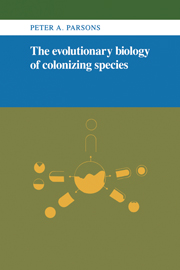Book contents
- Frontmatter
- Contents
- Preface
- 1 Introduction: Colonists and habitats
- 2 Genetics and ecology
- 3 Physical conditions, resources, and ecological phenotypes
- 4 Variability in natural populations
- 5 Genetic variability, ecological phenotypes, and stressful environments
- 6 Colonizing phenotypes and genotypes
- 7 Behavioral variability in natural populations
- 8 Habitat selection
- 9 The ecobehavioral phenotype: generalists and specialists
- 10 The ecobehavioral phenotype: biological control and domestication
- 11 Parasites and plants
- 12 Discussion and conclusions
- Appendix The study of quantitative traits
- References
- Index
6 - Colonizing phenotypes and genotypes
Published online by Cambridge University Press: 15 September 2009
- Frontmatter
- Contents
- Preface
- 1 Introduction: Colonists and habitats
- 2 Genetics and ecology
- 3 Physical conditions, resources, and ecological phenotypes
- 4 Variability in natural populations
- 5 Genetic variability, ecological phenotypes, and stressful environments
- 6 Colonizing phenotypes and genotypes
- 7 Behavioral variability in natural populations
- 8 Habitat selection
- 9 The ecobehavioral phenotype: generalists and specialists
- 10 The ecobehavioral phenotype: biological control and domestication
- 11 Parasites and plants
- 12 Discussion and conclusions
- Appendix The study of quantitative traits
- References
- Index
Summary
If therefore an organism be really in any high degree adapted to the place it fills in its environment, this adaptation will be constantly menaced by any unexpected agencies liable to cause changes to either party in the adaptation.
[Fisher, 1930:41]Genetic variability levels among widespread species
The comparative study of congeners is a potentially important approach in understanding adaptations of colonizing species and could reveal special genetic features of colonists, although many potential difficulties in this aim will be apparent from the previous two chapters. At the phenotypic level, there is certainly a parallel between the ecological phenotypes of marginal populations and the characteristics of colonizing species, by comparison with congeneric noncolonist species (Chapter 3). Here, the question is the degree to which this phenotypic conclusion can be applied at the genotypic level.
Commencing with the eight cosmopolitan Drosophila species that occur in the six biogeographical zones, Carson (1965) has classified them according to degrees of chromosomal morphism:
Polymorphism essentially ubiquitous; a few rare local aberrations – ananassae, busckii, hydei, immigrans, and melanogaster.
Polymorphism frequent and extensive in some populations but reduced in others – funebris.
Monomorphism throughout – repleta, simulans.
Considering the major subgenera of the genus Drosophila (Table 1.2), subgenus Drosophila (hydei, immigrans, funebris, repleta) is represented in all three categories, whereas the sibling species D. melanogaster and D. simulans are in different categories. Hence, there is no association with taxonomic divergence in contrast with resource-utilization patterns of three sympatric species of the Melbourne area (Section 3.4) and those of a number of species from a market in Leeds, England (Atkinson and Shorrocks, 1977).
- Type
- Chapter
- Information
- The Evolutionary Biology of Colonizing Species , pp. 87 - 108Publisher: Cambridge University PressPrint publication year: 1983



